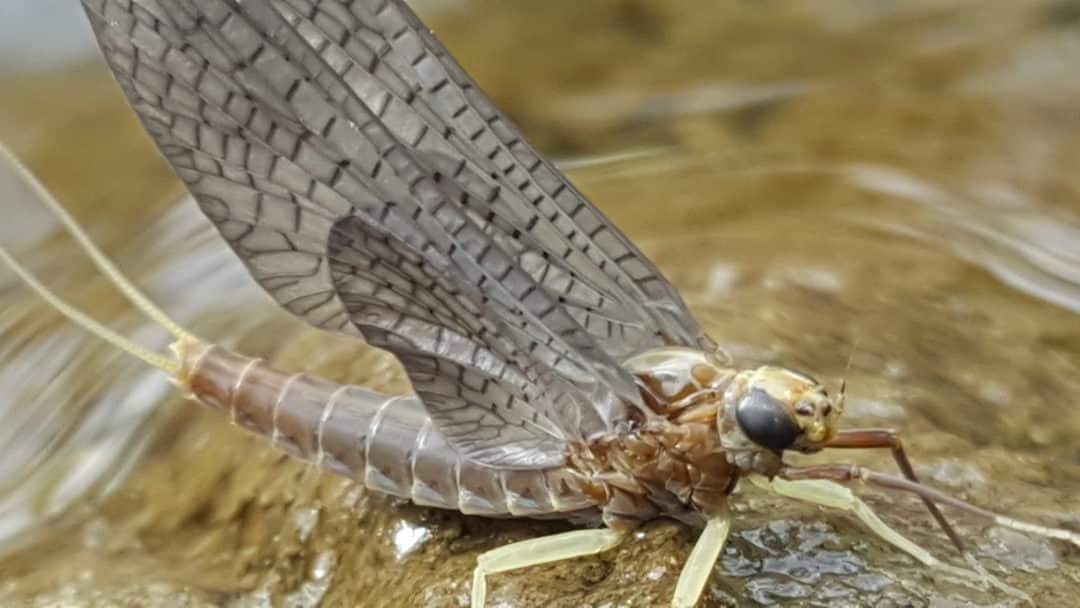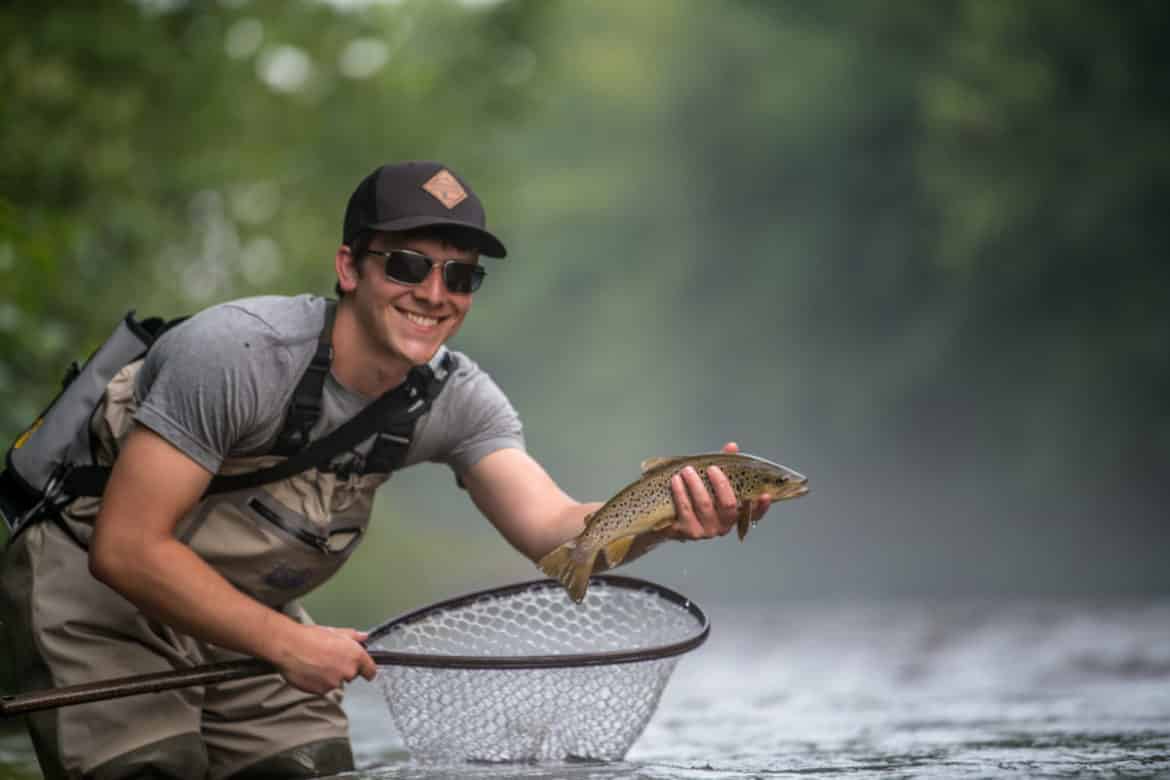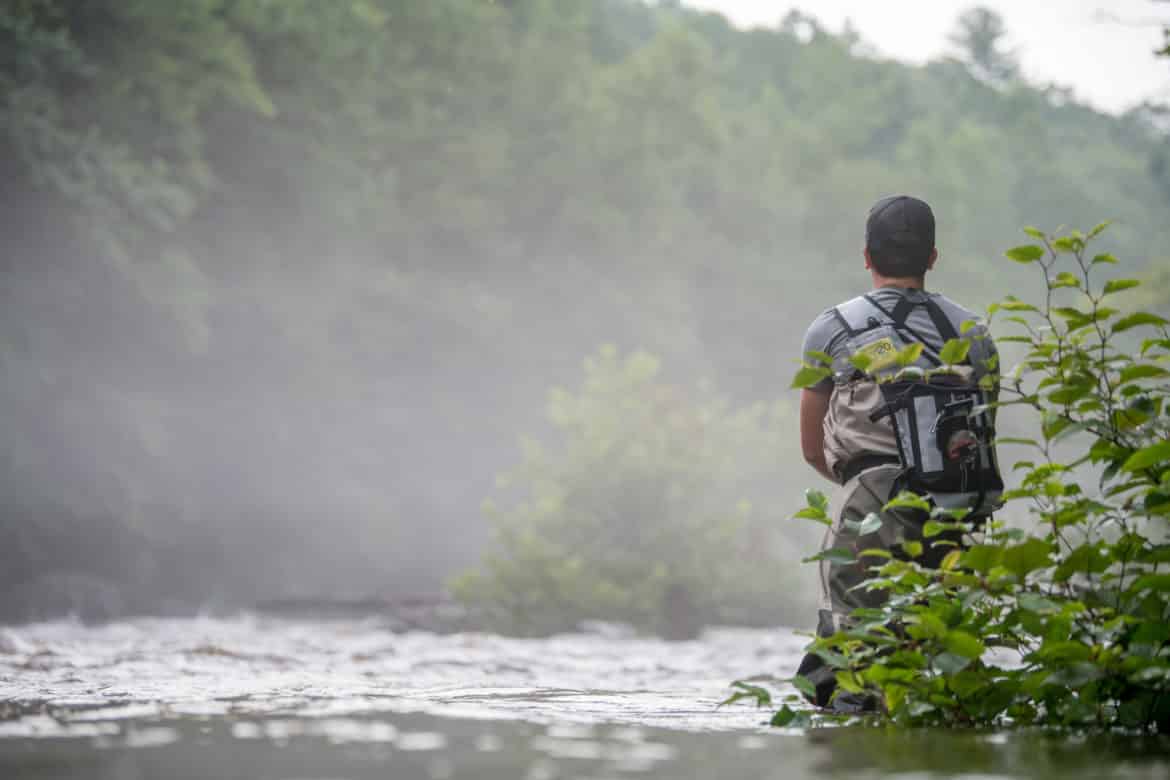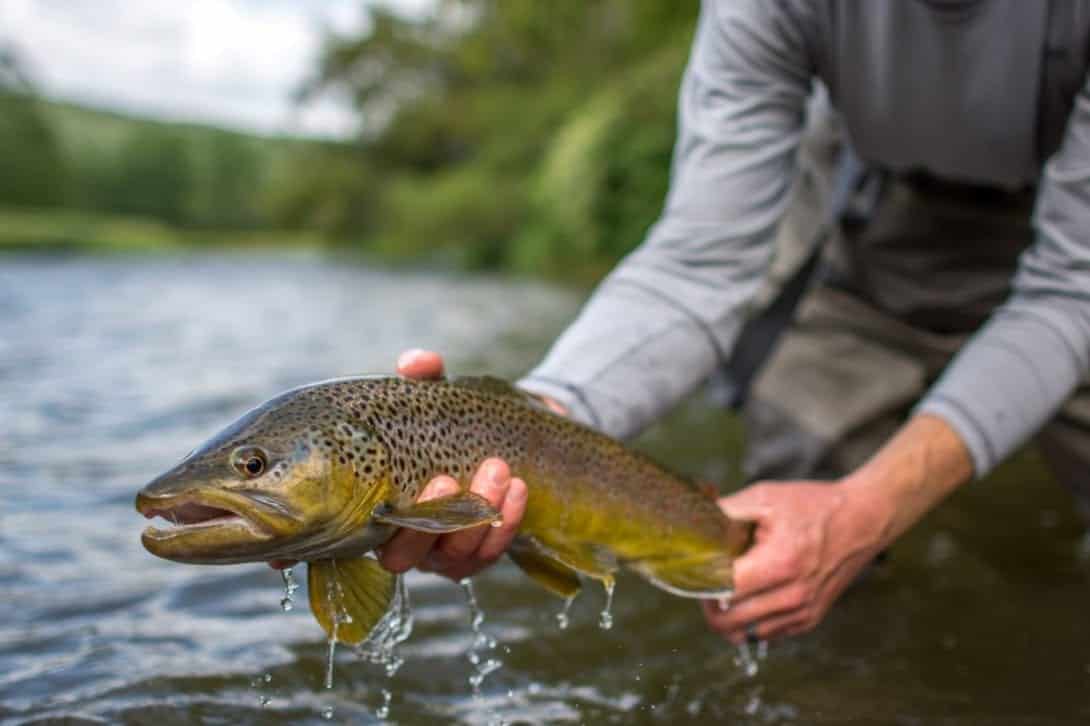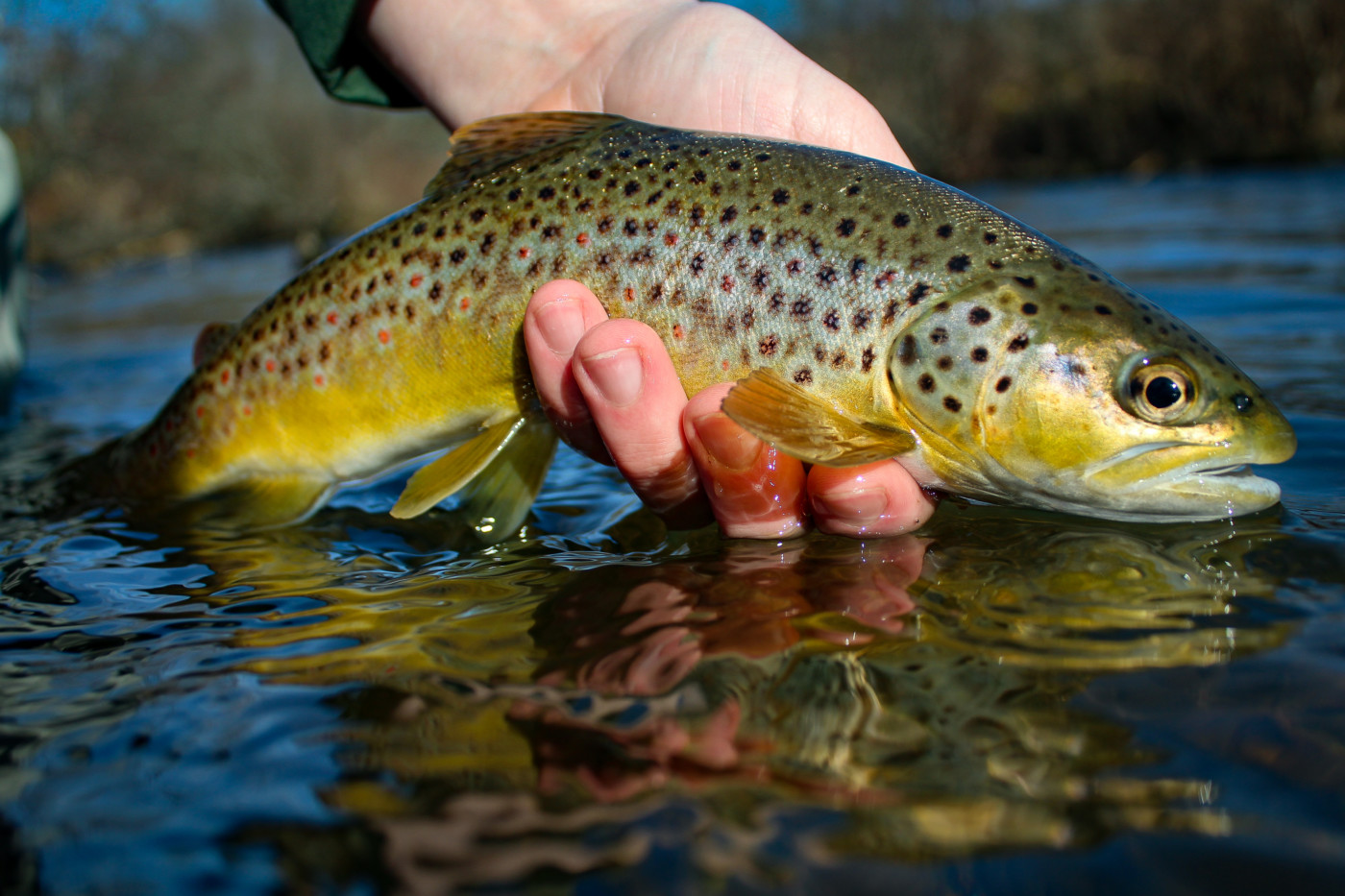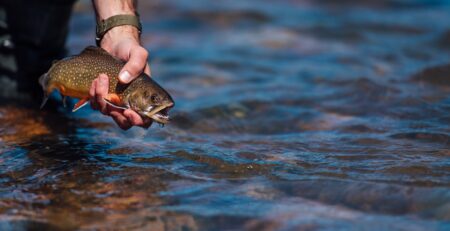How To Mend Your Fly Line When Fly Fishing
Presentation is everything in fly fishing. No matter which dry fly, emerger, nymph, or wet fly we choose to fish, ensuring that it is floating naturally in the water is critical to being successful at catching fish on a fly rod. In fly fishing mending is the tool that we use to achieve out goal. Reducing drag on our fly line and achieving a dead drift presentation is a key component to fly fishing.
To accomplish our goal of proper presentation an angler must counter major and minor water currents by mending the fly line. A mend is when you lift the rod tip and consequently, the fly line off the water to create an an arc of slack in a specific direction. This eliminates the pull of the river current on our line and flies. A mend can be performed either upstream or downstream. Although the technique of mending fly line is not overly complicated, it is often a difficult skill for beginners to master. In this article, we are going to give you practical tips, tricks, and strategies for mending fly line and improving your presentation.
Table of contents
Why is Mending Fly Line an Important Skill
Fish are interesting creatures. Trout especially, are fascinating because their instinct to survive and thrive in a hostile environment enables them to overcome almost insurmountable odds to survive. Trout have adapted to see tiny aquatic insects moving through the water column in slow and fast water.
Even more so, trout have the canny ability to detect differences in the speed of your fly and the speed at which natural insects are moving through the water. The tiny differences in speed are critical to whether or not a trout decides to take your flies. It is critical that anglers present their flies in a natural way, dead drifted with the natural flow of the river. Many anglers fail to present flies with a good drift that is drag free. A basic understanding of the insect lifecycle below the water will help conceptualize why anglers need to mend their fly line when fly fishing.
No matter what aquatic insect we are considering, all of them start their lives under a rock, burrowed in the mud, or attached to either a rock or submerged detritus. They spend the majority of their lives tucked away from predators and out of the reach of swift river currents. As light, water and air temperatures reach the correct tipping point, insects emerge from their hiding places and begin the hatching process.
Whether they crawl to shore or swim to the surface of the river, they are met with swift river currents moving at various speeds. This is the first moment in their lives in which they are vulnerable to predators. As they continue their migration to hatch, they are swept up in the current and float along at the same speed as the current. Trout, recognize these insects as food, and key in on the detail that entire hatch is more or less moving at the same speed as the variable currents in the river.
A fly anglers mending skills can make or break the day. If you fail to mend your fly line, then you your flies will fail to achieve a drag free drift and will most likely be refused. In addition, they the additional drag will pull the flies higher up into the water column and out of the strike zone.
Recommended Reading: Places Trout Will Hide And Where To Cast

Watch Your Fly Line
Fly line is an odd creature. It seems to rarely go where it is directed. Much like a wild horse, it has a mind of its own. Lovingly cared for and gently handled, it can be your best friend, try to control it, over power it, or be forceful with it and it has a mind of it’s own.
The behavior and drag created on a fly line in the water is dictated by several factors: water surface tension, currents, and wind are the major factors that effect fly line mending. Watching your fly line in the water, and understanding how it interacts with the above environmental factors will give you a better understanding of why mending fly line is important and how to do it effectively when you fly fish.
The surface tension created by water molecules is one of the main reasons we must mend our line. Overcoming this single factor, and separating the line from the water is key to mending fly line properly. We won’t get too scientific here, but water is made up of Hydrogen and Oxygen molecules. The hydrogen molecules are attracted to each other. The water molecules under the water are surrounded on all sides by other water molecules. The force exerted on each molecule is spread out evenly in all directions.
The water molecules on the surface of the water are only able to connect to other molecules to the left, right, and below them. This creates double the amount of energy and tension between the molecules on the surface of the water. This creates and extremely strong layer of water called the meniscus. The tension created by the meniscus is a strong barrier that not only grabs fly line, but also forms a barrier for hatching insects. The meniscus creates tension on the fly line, and this creates drag when you add currents into the formula moving at different speeds.
Understanding river currents and how they affect your fly line is key to achieving a drag free drift. There are both major and minor (micro) river currents. Major river currents are the ones you can cleary see, the minor ones are so subtle that sometimes you cannot see them. They may be mere inches in width, a subtle seam coming off a slightly submerged rock. Pay close attention, and these microcurrents become more perceptible.
When casting a fly line to a distant fish, it is conceivable that you could be casting across hundreds of different currents both major and micro moving at different speeds that will affect your fly. Mending helps us mitigate the effects of surface tension and drag created by all the currents. The effect on a fly line can be so subtle that drag on your fly is so subtle that you cannot see it with the naked eye.
Both types of currents are created by the flow of the water coming into contact with objects in the river. A change in current can be created by rocks, log jams, shelves, streamside debris, bends in the river, and just about any other object that impedes the flow of water.
Strong wind can also play a factor in fly line control and mending. On extremely windy days, lifting your rod tip and mending your line will often result in a loss of control of the line. This creates more drag on your fly and inhibits a proper presentation when casting.
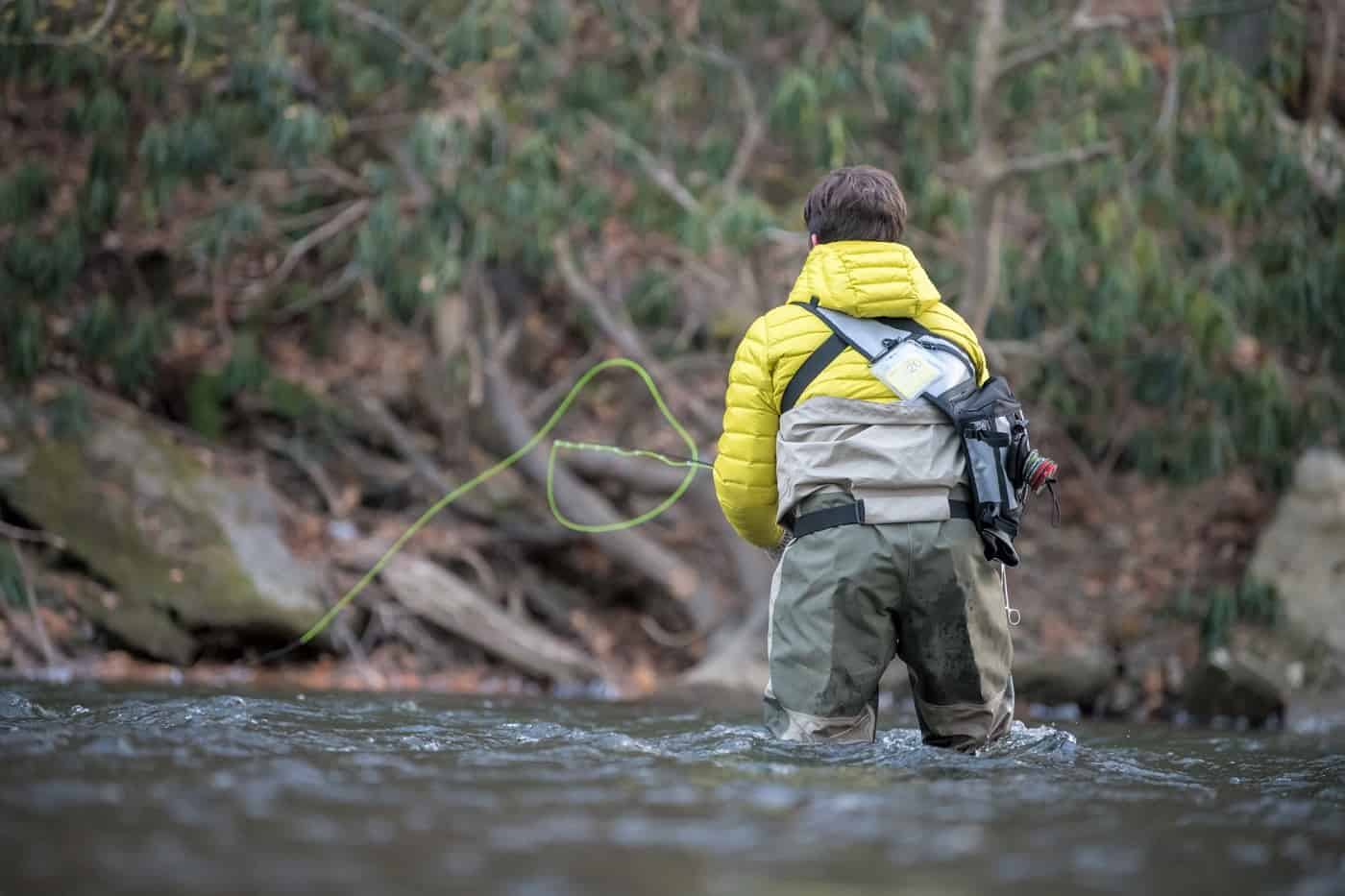
Fly Line Mending Basics
Now that we have a better understanding of the physical forces that we are up against, we are to discuss mending techniques to eliminate drag. The goal is to move the fly line upstream or downstream of the angler depending on the situation.
If you are fly fishing beginner, practice mending with a shorter cast in slower moving water. Once the muscle memory develops, move to long casts in fast water. We will cover advanced mending techniques in later in the article. For now, we will discuss the finer points of an upstream mend.
Performing A Basic Upstream Mend
In this scenario, the angler is wade fishing in a river. The angler is casting upstream at a 45-degree angle. The current of the river is moving from right to left in a mostly uniform manner. The angler makes his presentation upstream at a quartering angle in hopes he catches a trout quartering upstream from his position.
As the line touches the surface of the river, it begins to drift downstream and toward the angler. The tension of the water on the fly line starts to create a noticeable downstream bow in the fly line. As the fly moves toward the fly fisherman, drag begins to occur. Drag is detected by a small wake coming off of dragging dry flies or an indicator. It is at this moment, that an upstream mend is necessary to achieve drift drag free.
When Do I Mend the Fly Line
When the flies or indicator reach a point that is slightly upstream of, or perpendicular to the angler, this is the right moment to perform a upstream mend. An excellent tip for discerning when to mend your fly is to pay close attention to other objects floating in the water. Bubbles, a small piece of grass, or small sticks are all excellent markers. Compare your strike indicator or dry fly to the object floating naturally in the water. Your flies or indicator should be moving at the exact same speed. As they start to move faster than those objects, then it is time to mend your fly.
The key to a good mend is the height at which you raise your casting arm. Raise it high in the air. I prefer to raise my arm above my head. Raising your casting arm high in the air raises the rod tip and creates leverage over your fly line. The more leverage you have over the fly line, the easier it is to separate your fly line from the surface of the water and perform a proper fly fishing mend. In addition, you can mend the entire line in a single mend.
With the rod tip and your arm raised to shoulder height or above, perform an upstream flipping motion with your arm and wrist. A good analogy that I often use with clients, is to visualize yourself turning a giant tandem jump rope. When turning a tandem jump rope with a partner, if you only use your wrist and keep your arm at waist height, the rope is turned low to the ground.
The bow in the jump rope is relatively small, and it is harder to turn the entire rope. The higher you raise your arm, the more rope you can turn. The result is nice huge bows in the line, and it is much easier to turn the rope. The same principles and techniques in turning a jump rope, apply to mending techniques.
An often overlooked aspect of mending is line management with your noncasting hand. Once your fly line lands on the water on a upstream cast it will immediately float back toward you creating slack. Slack in the line will make line mending difficult, in addition to setting the hook. As the line drifts toward you strip in excess slack with your non-casting hand.
Excess line is an advantage when not fishing from a drift boat. As the fly drifts past you, presenting a fly downstream is achieved by feeding out the excess line that has accumulated. Wiggle your rod tip back and forth to add slack to a downstream drift. Feed slack and excess line with the noncasting hand. A longer dead drift will keep your flies in the strike zone for as long as possible.
You May Need To Change Mending Direction During The Drift
When fly fishing, it is common to encounter areas in the river where slower moving currents meet faster moving currents. These intersections are called seams. Seams are most obvious when fly fishing close to the bank. The main current of the river in the middle of the river is much faster than the slower water next to shore. The slower water is created by bends in the river. The water on the outside of a bend will be moving the fastest. The current on the inside of the bend will be the slowest. Many times currents can also be flowing in opposite directions. This is a common occurrence in back eddies.
When an angler encounters these scenarios fly fishing, it requires mending in a downstream direction. This is necessary because a long cast across the slow water and into the fast moving water creates a downstream hinge point at the seam. The slow water at the end of your rod tip is grabbing the fly line. The fly hits the fast moving current beyond the seam and immediately a hinge in the line is created where the fast and slow water meet. The fast current sweeps the fly downstream of the line in an instant. This creates a downstream “L” shaped pattern. This requires a downstream mend to lift the line off the slower water to ensure a drag free drift.
You Can Lift Your Fly Or Strike Indicator Off The Water During Your First Mend
The goal of mending your fly fishing line is to reduce drag and achieve a drag free drift, but we also want to mend as little as possible. Overmending is a common beginner mistake. The angler must strike a balance when mending their fly line. Too much mending and you are moving your flies, not enough mending and the flies are dragging. The ideal solution is one big mend that efficiently puts the lineup stream of the flies, which is much better than a bunch of little mends.
How much fly line should you mend? Unless there is an unusual scenario, the entire fly line and some of the leader if not all of it should be mended. When nymph fishing, I prefer to use my indicator as a hinge point. Performing one large mend with the goal of mending the entire fly line upstream to the indicator.
On the first mend when nymphing, I want my indicator to come out of the water an inch or two. This picks the flies up and allows them to fall vertically. This “resetting” of the nymphs gets them down to the right depth as quickly as possible. If multiple mends are needed, then the goal of any mend after that should be to mend as much line as possible without moving the indicator.

Be More Subtle When Dry Fly Fishing
When fly fishing dry flies, the goal is the same: get the fly line upstream, and eliminate drag. However, the mend must be more delicate, as there is less tension between your flies and the surface of the water. Therefore, an aggressive mend will pull the flies off the water, or entirely out of the intended fishing lane.
Advanced Mending Techniques
Advanced mending techniques are useful tools when currents moving at vastly different speeds create difficult fishing scenarios. Fly fishing rivers with fast water or areas where slower water and fast water meet often pull flies out of the strike zone resulting in hard to reach fish. This results in poor presentation and fewer fish caught. Fortunately, there are some mending techniques that help anglers solve these problems.
The Reach Cast
The reach cast, or a reach mend, is a technique that allows an angler to perform an aerial mend during the forward cast. The reach cast has many advantages. It is especially useful when making long casts across fast water. A reach cast can be used when casting in any direction: upstream, downstream, or directly across from the angler.
Performing a reach cast is very simple. As you make your forward cast to the target, while the fly line is almost completely unrolled and in the air, reach your rod tip to either the right or left and place the line downstream or upstream of the fly depending on the situation. As your fly fishing line and fly hits the water, you are in a better position, because your line and fly are starting their drift at a better angle.
Essentially, this is an aerial mend. Your fly line has already been mended once before the line hits the water. This eliminates excessive line mending and reduces drag on the anglers fly line for a few seconds, allowing for a better drift and longer presentation.
Recommended Reading: Quick Tips To Improve Your Cast

Zipper Mending techniques
The zipper mend was taught to me by Rod Bowden, a senior guide at World Cast Anglers, early in my guide career. This technique works well both wade fishing and fishing from a boat. It works particularly well when fishing from a dory or raft. The purpose of the zipper mend is help with mending on extremely windy days.
Windy days make fly line mending a difficult task. When fly fishing from a boat and the situation calls for a mend into the wind, the moment the rod tip is lifted into the air and line is separated from the water, it is blown back toward the angler. This can be frustrating to fly fish in these conditions for beginners and experts alike.
The solution is to zipper mend. A zipper mend requires the angler put the first few inches of the rod into the river at 90 degree angle to the boat. Remove almost all the slack from the line prior to mending. Using the tip of the rod, make a parallel line in the water. The parallel slashing motion will mend the fly line without the line ever leaving the water. This motion drags the line through the water, and changes the angle to the fly. This eliminates the need to lift the line out of the water. It prevents the line from being blown back into the angler when trying to mend into the wind.
Is There Anything You Can Do When Mending Doesn’t Seem To Be Working
Sometimes it seems that no matter what you do, you just cannot get a good mend, and thus a good drift for your fly. There are few things you can to do to achieve a drift in tough fly fishing situations. Before you change your leader or flies, change your position to the fish.
Sometimes, changing your position slightly upstream or downstream of a fish will allow for an extra few inches of drift. In addition, depending on the currents, a quartering presentation might not be possible at all. Positioning yourself directly below a fish and casting upstream to the target might be the best option. In addition, making a cast from directly above a fish downstream is a good option too. Downstream presentations require stealth because the angler will be directly in the line of sight of the target.
Lengthening your leader is an option too. This is especially effective when fishing dry flies and utilizing a wiggle cast or pile cast. If you fish a 9′ leader, add a foot or two of tippet to the leader. This extra length allows for extra slack in the leader, thus giving your flies more time on the water before the current grabs them. While you lose some casting accuracy with a lengthened leader, a longer leader can make a huge difference in achieving a good drift. Adding a pile or wiggle cast to the mix makes this tactic extremely effective.
I prefer a pile cast to the wiggle cast as it is easier to perform in my opinion. The pile cast is performed on the forward cast. Instead of speeding up the rod tip and stopping, the forward cast is performed with a wide and loose loop. As the flies drop toward the water, lazily dropping the rod tip to the water, results in a pile of fly leader that gathers around the flies. This buys the angler time and presents the flies accordingly.
Fly Fishing Made Easy 👍
Our Quarterly Fly Club ships 1,000’s of flies to anglers all across the United States. Receive curated fly assortments selected for the season with in-depth articles on how to fish them. Great for beginners to learn and for intermediates to discover new flies.





